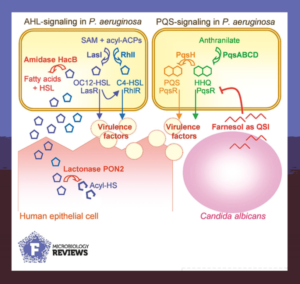For decades, antibiotics have helped us successfully fight many diseases. Their overuse and misuse, however, have led to the emergence of bacteria that no longer respond to these drugs. This makes antimicrobial resistance a significant public health threat around the world and requires us to find alternative treatments. In this #FEMSmicroBlog, Mariella Bodemeier Loayza Careaga discusses how scientists are exploring quorum quenching as a promising strategy to combat drug-resistant bacteria. #MicrobiologyIsEverywhere
Quorum sensing: Bacterial talk and disease
Communication is key this is true for both microorganisms and humans. Many bacteria have evolved mechanisms for cell-to-cell communication known as quorum sensing. For this, bacteria secrete and sense diffusible molecules, or autoinducers, to coordinate collective behaviors after reaching a certain number of individuals — the so-called quorum.
Some pathogenic bacteria require quorum sensing-regulated functions to cause disease in humans and other organisms. For instance, Pseudomonas aeruginosa uses quorum sensing to form biofilms that shield the bacterial community from antibiotics. This bacterium also employs quorum sensing to regulate the production of virulence factors to promote tissue damage and impair host immune defenses.

Given that quorum sensing contributes to bacteria’s ability to cause disease, researchers have been exploring whether disrupting this mechanism could be a way to treat infections and curb bacterial antimicrobial resistance.
Quorum quenching: Quieting the bacterial crowd
As bacteria evolved quorum sensing signals to adapt to ever-changing environments, so have the mechanisms to counteract these signals. These neutralizing processes — collectively known as quorum quenching — are used either by bacteria to clean up their own quorum sensing signals or by other organisms to control quorum sensing-producers.
Quorum quenchers can be divided into two classes. Quorum quenching enzymes modify or degrade quorum sensing signals. Quorum sensing inhibitors are chemical compounds that interfere with quorum sensing by disrupting the production, cell-to-cell exchange, or sensing of autoinducers.
In the early 2000s, scientists first demonstrated naturally occurring quorum quenchers in a Bacillus sp isolate. The identified enzyme, lactonase AiiA was shown to hydrolyse and thus inactivate N-acyl homoserine lactones, which are common quorum sensing signals in many Gram-negative bacteria.
What’s more, plants expressing lactonase appear to be more resistant to infection by pathogenic bacteria, such as Erwinia carotovora. Since then, researchers have continued searching for quorum quenching enzymes.
An example of such efforts is the study “Purification and characterisation of a quorum quenching AHL-lactonase from the endophytic bacterium Enterobacter sp. CS66” in FEMS Microbiology Letters. Researchers identified an AHL-degrading enzyme, this time from an Enterobacter strain found in a medicinal tree. When expressed in a plant pathogen, the lactonase leads to reduced secretion of virulence factors, suggesting a biocontrol activity of the enzyme.
While quorum quenching enzymes may be useful as antimicrobial agents, finding enzymes that are stable and can target a wide range of bacteria remains challenging. According to the study “Disrupting quorum sensing as a strategy to inhibit bacterial virulence in human, animal, and plant pathogens” in Pathogens and Disease, hyper-thermostable lactonase variants from an archeon affect several quorum sensing-regulated processes in some bacterial pathogens.
Quorum sensing inhibitors also show promise against pathogenic bacteria. The study “3-indoleacetonitrile attenuates biofilm formation and enhances sensitivity to imipenem in Acinetobacter baumannii” in Pathogens and Disease, demonstrated how 3-indoleacetonitrile, a molecule found in some vegetables, reduced biofilm formation in Acinetobacter baumannii. More interestingly, Acinetobacter baumannii was more sensitive to antibiotic treatment when exposed to 3-indoleacetonitrile, suggesting it may be used in combination with antibiotics to treat pathogenic infections.
Quorum quenching-based antibacterial treatments: A real possibility?
Targeting quorum sensing mechanisms seems to be an effective approach to curb bacterial infections. However, to translate these experimental findings into real-world applications, we still need to decipher how to deliver these agents and limit their effects to the target bacterial population.
We also need to gain a more comprehensive picture of their cytotoxic, adverse effects, and interactions with existing treatments. Despite these challenges, quorum quenching-based approaches hold promise in the search for alternative strategies to combat antibiotic-resistant bacteria.
-
Read the article “Purification and characterisation of a quorum quenching AHL-lactonase from the endophytic bacterium Enterobacter sp. CS66” by Shastry et al. (2018) in FEMS Microbiology Letters.
-
Read the article “Disrupting quorum sensing as a strategy to inhibit bacterial virulence in human, animal, and plant pathogens” by Gonzales et al. (2024) in Pathogens and Disease.
-
Read the article “3-indoleacetonitrile attenuates biofilm formation and enhances sensitivity to imipenem in Acinetobacter baumannii” by Kashyap et al. (2022) in Pathogens and Disease.

Mariella Bodemeier Loayza Careaga is a neuroscientist turned science writer who grew up in Brazil and now lives in the United States. Although she loved studying the brain, she realized during her Ph.D. that she wanted to learn more about other areas of science and even topics in neuroscience that were not closely related to her research project. This motivated her to pursue a career in science writing, which she has been doing since 2023. Her work has appeared in The Scientist, Drug Discovery News, and others.
About this blog section
The section #MicrobiologyIsEverywhere highlights the global relevance of microbiology. The section acknowledges that microbiology knows no borders, as well as the fact that microbiologists are everywhere and our FEMS network extends well beyond Europe. This blog entry type accepts contributions from excellent blogs translated into English. Regional stories with global relevance are welcomed. National or international events sponsored, organised or connected to FEMS are also covered.
| Do you want to be a guest contributor? |
| The #FEMSmicroBlog welcomes external bloggers, writers and SciComm enthusiasts. Get in touch if you want to share your idea for a blog entry with us! |
